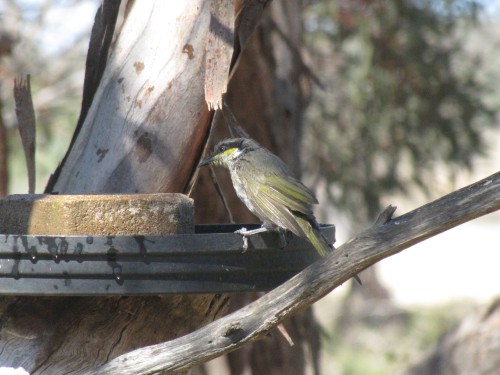Singing Honeyeater at the birdbath
Yesterday I wrote about New Holland Honeyeaters bathing in our bird bath (click here to view that post).
While the New Hollands are by far the most frequent and noisiest of the visitors to the bird bath, many other species also come to bathe or drink during our hot spells in summer. The New Holland Honeyeaters may come individually, but they are more prone to come in a flock of a dozen or more. The result is usually very noisy – and water sprays everywhere.
By way of contrast, the Singing Honeyeater shown in today’s photo quite often comes alone, or at most, two. They tend to be far more solitary birds in our garden. They often wait a short distance away while other species drink, then slip in quietly to drink when calmness returns.
Another unusual visitor to our bird bath
In recent times I have written about the behaviour of various species of birds at the bird baths we have in our garden. The birds give us many hours of entertainment as they come to drink and bathe. The very hot weather we have been having this summer helps to encourage their frequent visits.
I also wrote recently about some unusual visitors to the bird baths, a Stumpy Tail Lizard and a Red Fox.
A few days ago I was alerted to the alarm calls of a flock of New Holland Honeyeaters near the bird bath. I quietly went to have a look. The NHHEs were soon joined by several Singing Honeyeaters and a family of White Browed Babblers. All were calling madly and looking at the ground near a bush.
I waited for a few moments, fully expecting a Brown Snake (highly venomous) to emerge from the undergrowth. I had my camera at the ready and my feet ready to take off if a hasty retreat was in order.
To my great relief it was only a Blue Tongue Lizard. With the stripes on the back and tail, and a thin, long snake-like tail we have often been fooled into thinking we have a Tiger Snake (also quite venomous) in the garden. (They actually look nothing like a Tiger Snake; it’s the stripes that catch you by surprise every time.)
The new visitor didn’t wait to have a drink. A slight movement from me sent it slithering – almost snake-like – into the undergrowth again.
Related articles:
- Some unusual visitors to our birth bath – with photos.
- Time for a bath – with more photos
Updated November 2103

